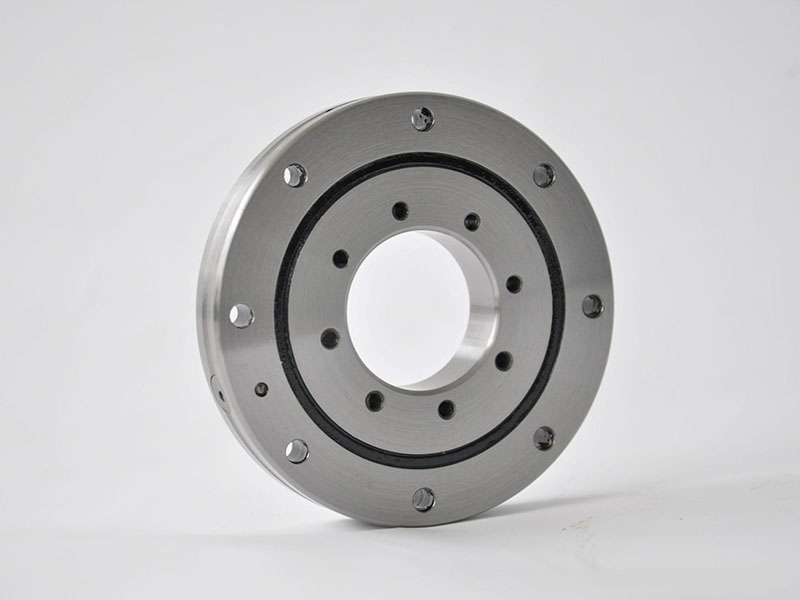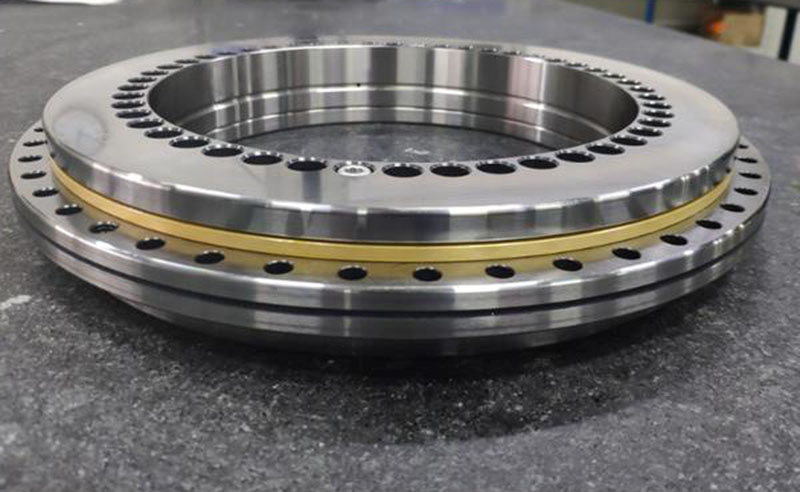1. Damage phenomenon of slewing bearing
In various construction machinery such as truck cranes and excavators, the slewing ring is an important part that transmits the axial load, radial load and tipping moment between the turntable and the chassis.
In light load conditions, it can work normally and rotate freely. However, when the load is heavy, especially at the maximum lifting capacity and the maximum range, it is difficult for the heavy object to rotate, or even cannot rotate at all, so that it is stuck. At this time, methods such as reducing the range, adjusting the outriggers, or moving the chassis position are usually used to tilt the body to help realize the rotary motion of the heavy object and complete the scheduled lifting and other operations. Therefore, during the maintenance work, it is often found that the raceway of the slewing bearing has been seriously damaged, and annular cracks along the direction of the raceway are generated on both sides of the inner race and the lower raceway in front of the working area, causing the upper raceway of the raceway to be depressed in the most stressed area. , and produce radial cracks throughout the depression.
2. Discussion on the causes of damage to slewing bearings
(1) The influence of the safety factor The slewing bearing is often operated under the condition of low speed and heavy load, and its carrying capacity can generally be expressed by static capacity, and the rated static capacity is recorded as C0 a. The so-called static capacity refers to the bearing capacity of the slewing bearing when the permanent deformation of the raceway δ reaches 3d0/10000, and d0 is the diameter of the rolling element. The combination of external loads is generally represented by the equivalent load Cd. The ratio of static capacity to equivalent load is called the safety factor, denoted as fs, which is the main basis for the design and selection of slewing bearings.
When the method of checking the maximum contact stress between the roller and the raceway is used to design the slewing bearing, the line contact stress [σk line] = 2.0~2.5×102 kN/cm is used. At present, most manufacturers select and calculate the type of slewing bearing according to the size of the external load. According to the existing information, the contact stress of the slewing bearing of the small tonnage crane is smaller than that of the large tonnage crane at present, and the actual safety factor is higher. The larger the tonnage of the crane, the larger the diameter of the slewing bearing, the lower the manufacturing accuracy, and the lower the safety factor. This is the fundamental reason why the slewing bearing of the large-tonnage crane is easier to damage than the slewing bearing of the small-tonnage crane. At present, it is generally believed that the line contact stress of the slewing bearing of a crane above 40 t should not exceed 2.0×102 kN/cm, and the safety factor should not be less than 1.10.
(2) Influence of the structural stiffness of the turntable
The slewing ring is an important part that transmits various loads between the turntable and the chassis. Its own stiffness is not large, and it mainly depends on the structural rigidity of the chassis and turntable that support it. Theoretically speaking, the ideal structure of the turntable is a cylindrical shape with high rigidity, so that the load on the turntable can be evenly distributed, but it is impossible to achieve due to the height limit of the whole machine. The finite element analysis results of the turntable show that the deformation of the bottom plate connected to the turntable and the slewing bearing is relatively large, and it is even more serious under the condition of large partial load, which causes the load to concentrate on a small part of the rollers, thereby increasing the load of a single roller. The pressure received; especially serious is that the deformation of the turntable structure will change the contact condition between the roller and the raceway, greatly reduce the contact length and cause a large increase in contact stress. However, the calculation methods of contact stress and static capacity widely used at present are based on the premise that the slewing bearing is evenly stressed and the effective contact length of the roller is 80% of the roller length. Obviously, this premise does not correspond to the actual situation. This is another reason why the slewing ring is easy to damage.
 (3) Influence of heat treatment state
(3) Influence of heat treatment state
The processing quality of the slewing bearing itself is greatly affected by the manufacturing accuracy, axial clearance and heat treatment state. The factor that is easily overlooked here is the influence of the heat treatment state. Obviously, in order to avoid cracks and depressions on the surface of the raceway, it is required that the surface of the raceway must have sufficient hardened layer depth and core hardness in addition to sufficient hardness. According to foreign data, the depth of the hardened layer of the raceway should be thickened with the increase of the rolling body, the deepest can exceed 6mm, and the hardness of the center should be higher, so that the raceway will have a higher crush resistance. Therefore, the depth of the hardened layer on the surface of the slewing bearing raceway is insufficient, and the hardness of the core is low, which is also one of the reasons for its damage.
(1) Through finite element analysis, appropriately increase the plate thickness of the connecting part between the turntable and the slewing bearing, so as to improve the structural rigidity of the turntable.
(2) When designing large-diameter slewing bearings, the safety factor should be appropriately increased; appropriately increasing the number of rollers can also improve the contact condition between the rollers and the raceway.
(3) Improve the manufacturing accuracy of the slewing bearing, focusing on the heat treatment process. It can reduce the intermediate frequency quenching speed, strive to obtain greater surface hardness and hardening depth, and prevent quenching cracks on the surface of the raceway.
Post time: Mar-22-2023

